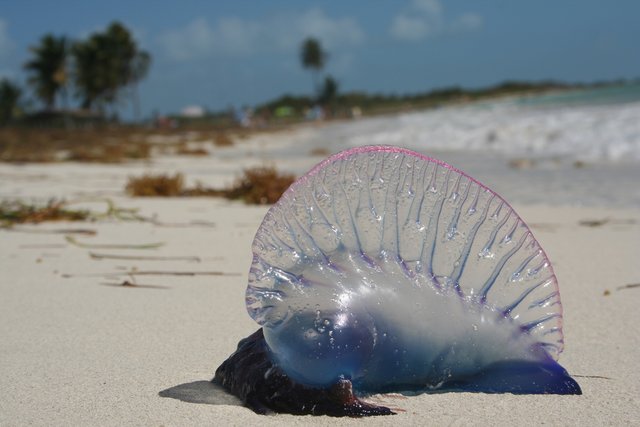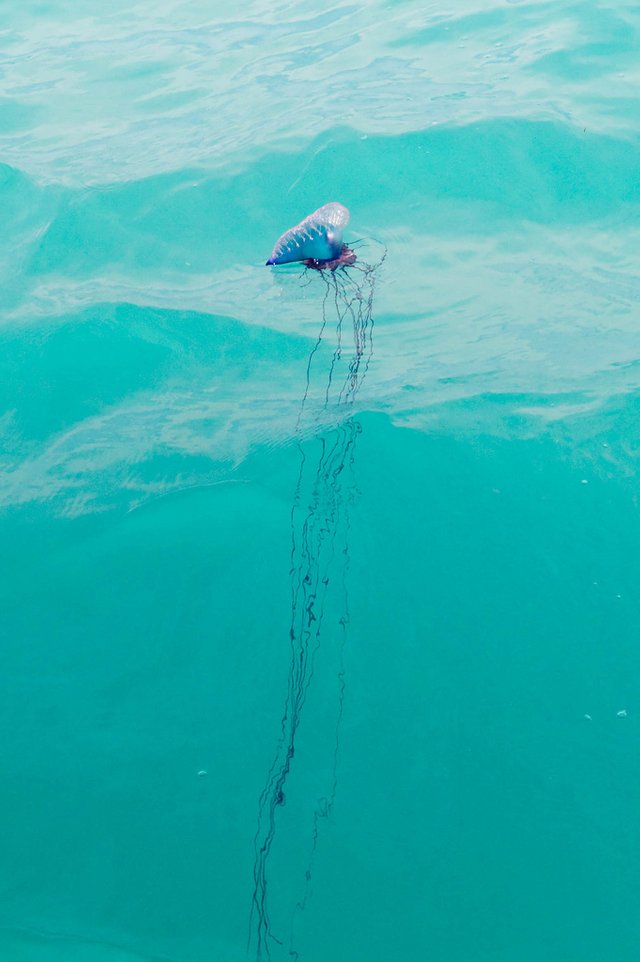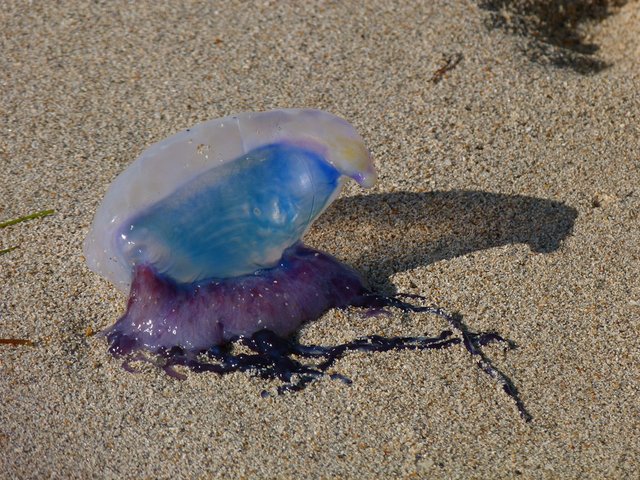The Blue Bubble
The Physalia physalis, typically called the Portuguese Man O' War, is usually described as a jellyfish, but this is not true. It's actually a siphonophore. A siphonophore is an animal that is made up of many organisms working together with individual polyps specified for such things as moving, feeding, asexual reproduction, and digestion. The Portoguese Man O' War is common around the tropics but can be found throught most of the Atlantic Ocean, Pacific Ocean, and Indian Ocean. It is a common food source for sea turtles.

Source: 4Neus---License
The Man O' War is made up of four polyps. The upper most polyp is what is used as a float. This polyp is where the name "Man O' War" comes from since it resembles a Portuguese Man of War ship from the 18th century when the polyp is full of Argon gas.
The second most important polyp is the one that consist of tentacles and stinging cells, nematocysts. This polyp is where the Man O' War catches all of its prey and essentially lets it feed. These tentacles can grow up to 165 feet long (~51 meters) but usually stay around 50 feet ( ~15 meters).
These tentacles also act as a defense mechanism since they are able to sting without feeding after. A sting can range from extremely painful to life threatening as some cases have been fatal.
As mentioned previously, there is a polyp specifically for reproduction.
According to marine biologist Helen Scales,
"They produce sperm and eggs. In fact, you get female and male Portuguese man-o-war, even though they're called "Men"!
The sperm will fertilise eggs in the water column to produce larvae, which grow into bigger Portuguese man-o-wars.
The way that they grow from those individual cells is by asexual division of those cells and they produce all those individual three types of animals that live in this one colony and drift around the oceans, stinging things and eating things as they go."
I'll leave this one to her explanation since it is a lot better than what I would be able to communicate.
The last polyp is for digestion. This is pretty simple: the prey is brought to the digestive polyp, digestive enzymes are released to breakdown proteins, carbahydrates, and fats, the enzymes liquify the organism, and then the leftover, non-liquid, remains are expelled.
Sources:
http://eol.org/pages/1005764/details
https://oceanservice.noaa.gov/facts/portuguese-man-o-war.html
http://www.untamedscience.com/biodiversity/portuguese-man-war/
http://oceana.org/marine-life/corals-and-other-invertebrates/portuguese-man-o-war


@branbello, this was a fascinating article with some great pictures included. I learned a lot! It is quite amazing that a creature such as this even exists. What an exquisitely designed organism to function as it does from the different polyps. And I had no idea the Man-O-War was a favorite food of sea turtles.
I've upvoted and resteemed this article as one of my daily post promotions for the @mitneb Curation Trail Project. It will be featured in the @mitneb Curation Trail Project Daily Report for 23 FEB 2018.
Cheers!
Thank you so much.
Hope you learned at least something from this post. :)
For some strange reason, I have the affection to those gelly weird creatures...
Same! I've been stung by my fair share of jellyfish and this has caused me to have a love/hate relationship with all Cnidaria.
This post has received a 0.16 % upvote from @drotto thanks to: @banjo.
I've seen a few of these washed up on the shore when I was in Thailand. Definitely wore lycra when I went diving!
Do you focus on jellyfish in your studies? I tried eating jellyfish in Hong Kong and when I learned more about the nutritional facts I thought that it could make a decent filler/mixer for ground meats in case beef/pork ever got to be too expensive on its own.
Don't go close to them when they're washed up, they can still sting.
I'm actually focusing my undergraduate research on fiddler crabs at the moment. I typed up posts about them previously but nobody seems to find them interesting so I stopped doing that.
I didn't realize they were so small, and that the tentacles reached that far down! Going to think twice before going to Australia, thats for sure.
I'd worry about Australia besides these critters. This little guy is who I'd be looking out for in Australian waters.
You'd find more Portuguese Man O' War in the tropics than Australia.
I'm confused. Each polyp is a separate creature, or each polyp is a colony of dedicated creatures?
Trust me, I'm a doctor.
Sorry, I should've been more clear. Each polyp is made up of multiple organisms. For example: dactylozoids, make up the tentacles, gastrozoids eat the food, and gonozoids help with reproduction.
So think of the Man O' War being the United States for example and each polyp is a state and each state has its own cities that make it up.
Hope that didn't confuse you even more.
I saw a lot of documentaries about siphonophore but it's the first time I saw this type of siphonophore. I find them very interesting and might explain how we got to the complexity we are now. The missing link.
Well written article.
Holy hell. Thank you so much! I can't believe I didn't catch that.
I ran it through multiple spell checks too and it never showed as wrong.
Nice photo branbello i am photographer and i will resteem your post to my 2000 plus followers at very cheap rate 0.050 and if you also get my vote then sand0.070 its very cheap rate others get 0.500 for resteem .